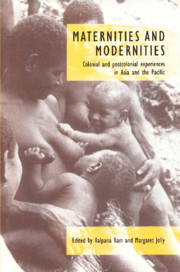Book contents
- Frontmatter
- Contents
- List of illustrations
- Notes on contributor
- Acknowledgements
- Map 1 Location of countries and regions in Asia and the Pacific discussed in this volume
- Introduction Colonial and postcolonial plots in histories of maternities and modernities
- 1 Shaping reproduction: maternity in early twentieth-century Malaya
- 2 Modernizing the Malay mother
- 3 ‘Good wives and mothers’ or ‘dedicated workers’? Contradictions of domesticity in the ‘mission of sisterhood’, Travancore, south India
- 4 Maternity and the story of enlightenment in the colonies: Tamil coastal women, south India
- 5 The dai and the doctor: discourses on women's reproductive health in rural Bangladesh
- 6 Other mothers: maternal ‘insouciance’ and the depopulation debate in Fiji and Vanuatu, 1890–1930
- 7 Just add water: remaking women through childbirth, Anganen, Southern Highlands, Papua New Guinea
- 8 From sisters to wives: changing contexts of maternity on Simbo, Western Solomon Islands
- Epilogue Maternal experience and feminist body politics: Asian and Pacific perspectives
- Index
6 - Other mothers: maternal ‘insouciance’ and the depopulation debate in Fiji and Vanuatu, 1890–1930
Published online by Cambridge University Press: 06 July 2010
- Frontmatter
- Contents
- List of illustrations
- Notes on contributor
- Acknowledgements
- Map 1 Location of countries and regions in Asia and the Pacific discussed in this volume
- Introduction Colonial and postcolonial plots in histories of maternities and modernities
- 1 Shaping reproduction: maternity in early twentieth-century Malaya
- 2 Modernizing the Malay mother
- 3 ‘Good wives and mothers’ or ‘dedicated workers’? Contradictions of domesticity in the ‘mission of sisterhood’, Travancore, south India
- 4 Maternity and the story of enlightenment in the colonies: Tamil coastal women, south India
- 5 The dai and the doctor: discourses on women's reproductive health in rural Bangladesh
- 6 Other mothers: maternal ‘insouciance’ and the depopulation debate in Fiji and Vanuatu, 1890–1930
- 7 Just add water: remaking women through childbirth, Anganen, Southern Highlands, Papua New Guinea
- 8 From sisters to wives: changing contexts of maternity on Simbo, Western Solomon Islands
- Epilogue Maternal experience and feminist body politics: Asian and Pacific perspectives
- Index
Summary
There is no State womb, there are no State breasts, there is no real substitute for the beauty of individual motherhood.
(Saleeby 1909:32)See that heathen mother stand
Where the sacred current flows
With her own maternal hands
Mid the wave her babe she throws
Send, Oh send, the bible there,
Lets its precept reach the heart;
She may then her children spare -
Act the tender mothers's heart,
(cited in Forbes 1986:WS-2)It is impossible to convince a tough old hag that her method of childrearing is wrong. She considers herself a living witness to its excellence.
(Durrad in Rivers 1922:15).Introduction
Maternity has often been proclaimed as a source of sameness and identification between women – we are all born of mothers, and although some of us cannot or do not become mothers, our being in a woman's body is often identified with its procreative potential. The identification of woman with the maternal has been implicated in many Western theories which purport to explain woman's essential condition – either our alleged universal subordination (Chodorow 1978; de Beauvoir 1972 (1949); Ortner 1974; Rosaldo and Lamphere 1974) or to explain and celebrate our difference from men (Gilligan 1982; Irigaray 1985; Kristeva 1980; Trebilcotl983).
Although maternity will, I imagine, continue to be a powerful factor in and a potent metaphor of women's identity and unity, what I consider here is rather how maternity has divided women – how class, race and nation have constituted us as ‘other mothers’.
- Type
- Chapter
- Information
- Maternities and ModernitiesColonial and Postcolonial Experiences in Asia and the Pacific, pp. 177 - 212Publisher: Cambridge University PressPrint publication year: 1998
- 32
- Cited by

